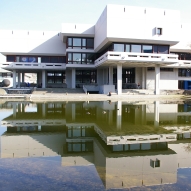| Dokumentenart: | Artikel | ||||
|---|---|---|---|---|---|
| Titel eines Journals oder einer Zeitschrift: | Phytochemistry | ||||
| Verlag: | PERGAMON-ELSEVIER SCIENCE LTD | ||||
| Ort der Veröffentlichung: | OXFORD | ||||
| Band: | 145 | ||||
| Seitenbereich: | S. 26-39 | ||||
| Datum: | 2018 | ||||
| Institutionen: | Chemie und Pharmazie > Institut für Pharmazie Chemie und Pharmazie > Institut für Pharmazie > Lehrstuhl Pharmazeutische Biologie (Prof. Heilmann) | ||||
| Identifikationsnummer: |
| ||||
| Stichwörter / Keywords: | CONDENSED TANNINS; BARK EXTRACT; POLYMERIC PROCYANIDINS; ARABIDOPSIS-THALIANA; HYPERICUM-PERFORATUM; SECONDARY CHEMISTRY; PHENOLIC GLYCOSIDES; SALIX-MYRSINIFOLIA; S-ERIOCEPHALA; GENE ENCODES; Salix species; Salicaceae; Willow; Proanthocyanidins; Condensed tannins; Flavan-3-ols; Metabolomics; Chemotaxonomy | ||||
| Dewey-Dezimal-Klassifikation: | 500 Naturwissenschaften und Mathematik > 540 Chemie 600 Technik, Medizin, angewandte Wissenschaften > 615 Pharmazie 500 Naturwissenschaften und Mathematik > 580 Pflanzen (Botanik) | ||||
| Status: | Veröffentlicht | ||||
| Begutachtet: | Ja, diese Version wurde begutachtet | ||||
| An der Universität Regensburg entstanden: | Ja | ||||
| Dokumenten-ID: | 36493 |
 Web of Science
Web of ScienceZusammenfassung
Flavonoids, proanthocyanidins (PAs) and salicylic alcohol derivatives are the main groups of ingredients in Salix needed as defensive tools and signal molecules, but have also pharmaceutical importance. The present study investigated total PA content, complete PA pattern, the oligomeric/total PAs quotient and the contents of catechin and epicatechin during one growing-season for the leaves and ...

Zusammenfassung
Flavonoids, proanthocyanidins (PAs) and salicylic alcohol derivatives are the main groups of ingredients in Salix needed as defensive tools and signal molecules, but have also pharmaceutical importance. The present study investigated total PA content, complete PA pattern, the oligomeric/total PAs quotient and the contents of catechin and epicatechin during one growing-season for the leaves and this year's sprouts in ten willows (Salix pentandra L. male, S. alba L. male, S. fragilis L. female, S. caprea L. male & female, S. cinerea L. male, S. caprea x cinerea male, S. daphnoides VILL. male & female and S. purpurea L. female; all Salicaceae). Comparison of the different species revealed distinct seasonal fluctuations of the oligomeric and polymeric PA fractions, but the contents of both groups always developed in the same direction. All willows prefer the synthesis of PAS with DP-2 - DP-4 within the oligomeric fraction (DP-2 - DP-10) and species with rather low PA contents like S. purpurea (0.1-2.6 mg/g) as well as species with rather high PA contents like S. alba (3.8-14.7 mg/g) were found. Only slight gender specific differences could be observed for both sexes of S. daphnoides and S. caprea. The PA pattern of the hybrid S. caprea x cinerea seems to be influenced by both parents. Thus, the accumulation of the oligomeric PAs accorded to S. caprea and the polymeric PAs matched S. cinerea resulting in an overall depression of PAs in the sprouts and a varying seasonal trend in the leaves. In contrast, the content of catechin remained high and seemed to be not influenced in the hybrid. Although only one individual of each Salix species could be considered in this screening study, the present results demonstrate the variability of the flavan-3-ol pattern within the genus Salix but also some preliminary correlations could be observed. Future studies with more Salix species will provide more insights into chemotaxonomic correlations. (C) 2017 Elsevier Ltd. All rights reserved.
Metadaten zuletzt geändert: 28 Mai 2018 07:17



 Altmetric
Altmetric